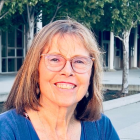Support strong Canadian climate journalism for 2025
As part of a series highlighting the work of young people in addressing the climate crisis, writer Patricia Lane interviews environmental scientist Kirsten Reid.
The 1990s were personally tough for me. I spent the decade immersed in action based on climate catastrophe science, trying, and by all accounts failing, to stem the tide. Hardest of all, death and dementia came to my family.
As my awareness deepened about the growing divide between young and old and rich and poor, grief had become a pretty constant companion. I could choose to go further into the abyss of fear and loss or choose the only thing stronger: love. To choose love is to hope. But I had forgotten how. So I made a resolution — one that could last a year or even a decade if need be. I chose to study hope.
Part of my journey is to seek out promising young people who are contending in evidence-based and impactful ways with the climate crisis and engage them in conversations about hope. I am grateful for Canada’s National Observer’s commitment to solutions journalism, which provides these determined, joyful and, yes, hopeful young people a voice.
In the race against rapid warming in the Arctic, 26-year-old Kirsten Reid hopes to help First Nations, settler governments and conservation groups identify species at risk and design conservation spaces and biodiversity corridors to protect fragile ecosystems. She is currently working in the high Arctic as part of her PhD at Memorial University of Newfoundland.

Tell us about your work.
Ecosystems in the North are being threatened on multiple fronts, from climate change, which affects where plants and animals can live, to human disturbances and development. While we can identify characteristics of the current landscape and how animals interact with it today, many species will need to shift their ranges, generally upslope or northward. If we can learn enough, we can design ecological connectivity to help species feed, migrate, mate and respond to climate and other environmental changes.
We have 14 study sites across 900 kilometres stretching from the southern Arctic all the way to the high southern Arctic. We are creating a sort of scientific archive — a memory — of the interlocking webs of life in each area. Take caribou: These creatures are such a dominant part of their ecosystems and are so culturally significant to Indigenous Peoples. But their habitat is fragile and their existence very much at risk.
If we can understand what they need now to survive and thrive, where those ecosystems are and where they might be in a future, warmer world, we can make space for their range to be protected and even expand. It is not inconceivable that we could have thriving caribou herds in the future, but it won’t happen without planning.
Indigenous people have kept this landscape healthy for tens of thousands of years. We need to push for ongoing and future natural science work in the North to be community-directed.
How did you get interested in this work?
One of my second-year courses had a field work component; I chose to go to the Arctic mostly out of sheer curiosity. I thought at worst, it would be freezing cold but good for some amusing stories. We were taken to a wildfire site. Wildfires are a natural part of the cycle of life in the North.
Our instructor asked us to consider what we saw. Then to ask what we did not see, and, finally, what we would never expect to see. When she finished by asking us what would have to change for that to be a reality in a future world, I was hooked. I fell in love with those questions and have been asking them ever since.
We had a tour of a large gold mine that was no longer operating. Looking like marshmallows in our hazmat suits, we went deep underground and saw that humans are keeping the ground frozen to stop the arsenic dust (a byproduct of the gold mining) from leaking into the ecosystem.
The guide told us that the previous guest had been then-Prime Minister Stephen Harper. I am pretty sure he saw it as a remediation jobs creator. But I saw the pollution that industry creates and how easy it is for humans to degrade these fragile ecosystems, which are already under such threat from global warming.
Do you have advice for other young people?
I never used to consider myself an environmentalist. I saw myself as a scientist. It wasn't until I got named one of Starfish Canada’s Top 25 Environmentalists Under 25 in 2019 that I saw that I am someone who cares so much about my work that I am also an environmentalist. Everyone can find their own niche, some more high-profile than others, and everyone can be a catalyst for change in their own way. It all matters.
As I spend more time with those others who are mostly advocates, I see more clearly every day that science and advocacy go well together.
What does support look like?
While small lifestyle or community-level changes are important, we really need widespread systems change. Use your power and resources to lobby decision-makers at the broadest scale. Be part of helping to stop drilling in the North. Make polluters stop or at least clean up after themselves. Support the really great NGOs on the ground, like the Yellowstone to Yukon Conservation Initiative and Wildlife Conservation Society Canada, that are doing such great science-based work to protect our North, which is essential to the health of the human species.







Comments